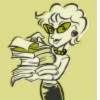 Say, Allen. 1997. ALLISON. Boston: Houghton Mifflin. ISBN 9-780329-39549-0
Say, Allen. 1997. ALLISON. Boston: Houghton Mifflin. ISBN 9-780329-39549-0PLOT SUMMARY
Allison and her doll, Mei Mei, live happily with her mother and father. One day, Allison notices she doesn’t look like her parents. When she realizes she’s been adopted, she bitterly focuses on the fact that her “real” parents didn’t want her and gave her away. As she broods and acts out, Allison struggles to deal with her anger. Finally, Allison is able to work through her feelings by taking a stray cat into their family.
CRITICAL ANALYSIS (INCLUDING CULTURAL MARKERS)
Allen Say tells an emotional story of a little girl dealing with her family. Through the use of plot, characterization (including voice), language, and illustrations, ALLISON conveys a realistic picture of how a child dealing with adoption might feel.
The story opens with Allison receiving a dress from her grandmother. Her parents “ooh” and “aah” over how pretty she looks wearing her kimono. The mother’s use of the term kimono is Allison’s first clue that there is something different about her. She realizes for the first time how differently she looks from her parents. The inevitable conversation takes place between the child and her adoptive parents, “You’re not my Mommy and Daddy?” she asks. To which her parents reply, “of course we are….” This exchange only serves to deepen Allison’s dismay. Her sadness comes to a climax when she realizes Allison is not her ‘real’ name. This plot shows a realistic journey of a young girl dealing with her identity.
The characters in ALLISON are neither homogenous nor stereotypical. The adoptive parents are hurt by Allison’s outbursts, yet they are patient with their daughter. Allison’s school mates, representing many different ethnicities, reflect varied skin tones, body shapes, and hair styles. Allison, who is adopted from an unspecified Asian country, also exhibits a non-stereotypical view of her ethnicity. Except for the time she is trying on her new kimono, Allison wears typical clothing for an American child.
Say’s use of voice further contributes to the characters’ believability. Allison’s question, “Where did Mei Mei come from?” accurately depicts a child’s tendency to project questions about themselves onto dolls or animals. Later, when Allison is acting out against her mother, she ruins her dolls. Rather than fuss at Allison, the mother laments, “Oh, no, poor [dolly]! I’ve had him since I was a little girl.” This type of response reveals a believable interaction between a mother and daughter which is full of anger and pain yet grounded in love.
The illustrations and use of Japanese words provide a fullness to ALLISON. Say’s ability to capture realization, anger, pain, and defiance in his characters’ faces is outstanding. At the story’s most painful moments, Say uses dark somber colors. At the end, Allison’s breakthrough with the stray cat is accompanied by bright sunlight and pastel background colors. Say tops off the cultural allusion by including words such as Mei Mei (the doll’s name), kimono, and obi.
ALLISON is a touching story about a family dealing with adoption. This realistically portrayed situation is conveyed through the adept use of literary tools and a sensitive yet authentic approach to ethnic diversity.
REVIEW EXCERPTS
“Her adoption of a stray cat brings about a happy ending that seems less earned than bibliotherapeutic. The large, sober paintings are often heavy, and the bookmaking, though handsome, is too big and elegant for the family drama it is meant to support.” (Horn Book)
“Cleverly, Say uses a stray cat that Allison wants to adopt to help her come to terms with her anger as she realizes everyone needs a family. A subtle, sensitive probing of interracial adoption, this exquisitely illustrated story will encourage thoughtful adult-child dialogue on a potentially difficult issue.” (Publishers Weekly)
“Say masterfully captures Allison's expressions: She is surprised, wounded, sullen, hurt and hurtful, and finally reassured. He addresses the dark side of an adoptive child's feelings carefully, and while the resolution is a bit convenient (and may require interpretation for younger children), it still carries truth.” (Kirkus Review)
Reviews obtained from Follett Library Resources and accessed at:
http://www.flr.follett.com
CONNECTIONS
Other books by Allen Say:
THE BICYCLE MAN, ISBN 978-0-395-32254-3
EL CHINO, ISBN 978-0-395-52023-9
EMMA’S RUG, ISBN 978-0-395-74294-5
Other books about adoption:
Lewis, Rose A. 2000. I LOVE YOU LIKE CRAZY CAKES. New York, NY : Little, Brown. ISBN 978-1-59990-017-9
Young, Ed. 2006. MY MEI MEI. New York, NY : Philomel Books. ISBN 978-0-395-74294-5
Friedrich, Molly. 2004. YOU’RE NOT MY REAL MOTHER! New York, NY : Little, Brown. ISBN 978-0-316-60553-3
Related website:
http://www.houghtonmifflinbooks.com/authors/allensay/

No comments:
Post a Comment